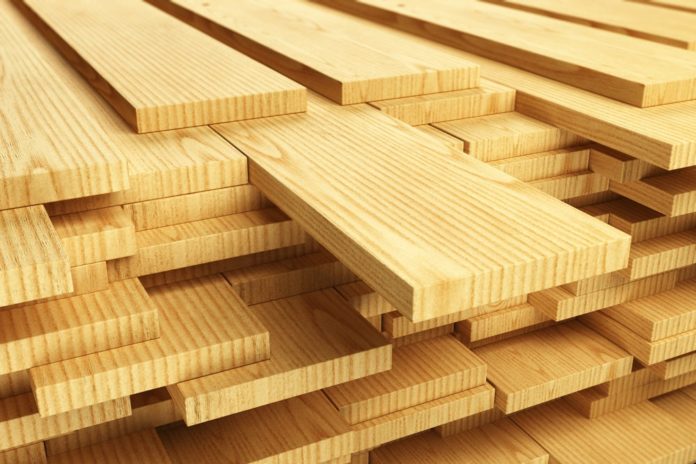Is it too late to consider lumber stocks?

Depositphotos.com contributor/Depositphotos.com – MarketBeat
Nosiree.
Lumber prices have boomed over the past two years for a number of reasons, but in large part due to homeowners trekking to home improvement stores for DIY projects over the pandemic. Home improvement spending ratcheted up 3% to $420 billion in 2020, according to a study by Harvard University’s Joint Center for Housing Studies (JCHS). Lumber prices continue to rise to a fever pitch in 2022 — yes, even after the price of lumber tumbled in 2021.
What gives?
According to the National Association of Home Builders (NAHB), there are a few reasons lumber continues to zip up:
- Ongoing supply chain issues for framing
- Tariffs on lumber increased, from about 9% to 17.9%, according to the U.S. Department of Commerce
- Domestic lumber production has lagged
- Historic flooding in British Columbia and Washington hit in 2021
Is that enough to convince you that the lumber industry has only to go upward?
What to Know About Lumber Stocks
Timber has been one of the most consistent investments over time, one of the commodities to not bend during inflation scenarios. Wood has risen 3% more than inflation for more than 90 years and timberland continues to beat the stock market, over and over.
Interest rates are still low, so piqued interest in home building is still on people’s minds. Though there’s still massive demand and little supply, it’s still a good time to jump on the bandwagon.
Not to mention, now Federal Reserve Chair Jerome Powell has said a shift in rising interest rates may not happen until 2024, which should keep mortgage rates low and keep construction from lagging.
Consider These 3 Lumber Stocks for a Portfolio Boost
Why invest in lumber and which stocks to put a pin in for either your short-term or long-term portfolio? Let’s find out.
Weyerhaeuser Co. (NYSE: WY)
Weyerhaeuser Co., headquartered in Seattle, manufactures, distributes and sells forest products. It has the following segments: timberlands, real estate, energy and natural resources. The company manages private commercial forestland worldwide, grows and harvests trees for lumber, building, pulp, paper and other wood products and delivers premiums to timber value by identifying and monetizing higher and better use lands. It captures the full value of surface and subsurface assets and delivers lumber, structural panels, engineered wood products and complementary building products for residential, multi-family, industrial and light commercial applications.
In 2021, Weyerhaeuser Co. achieved record full year net earnings of $2.6 billion, or $3.47 per diluted share, increased full-year adjusted EBITDA by 86% to a record $4.1 billion and generated record full year cash flow from operations of $3.2 billion and adjusted FAD of $2.6 billion. Finally, the company delivered a total cash return to shareholders of more than $2 billion.
UFP Industries Inc. (NASDAQ: UFPI)
UFP Industries Inc., headquartered in Grand Rapids, Michigan, manufactures and distributes wood and wood alternative products through its retail, industrial and construction segments. The retail segment ecompasses national home center retailers, retail-oriented regional lumber yards and contractor-oriented lumber yards and the industrial segment manufacturers pallets, specialty crates, wooden boxes and other containers used for packaging, shipping and material handling. The construction segment handles factory-built housing, site-built residential construction concrete forming and commercial construction.
UFP Industries Inc. shored up record net sales and net earnings for Q4 and fiscal year 2021. The company surpassed $8.6 billion in net sales for fiscal 2021 as well as record earnings per diluted share of $8.59, a 115% increase over last year. During Q4, net sales were $2 billion, a 45% increase over Q4 2020 and earnings per diluted share were $2.21, a 117% increase over Q4 2020.
In Q4, net sales of $2.02 billion increased 45%, earnings from operations of $195 million increased 121% and acquisitions contributed $19 million to earnings. New product sales of $189.1 million increased 42% and adjusted EBITDA of $223.3 million increased 89%.
West Fraser Timber Co. Ltd. (NYSE: WFG)
West Fraser Timber Co. Ltd., headquartered in Vancouver, British Columbia, Canada, is a diversified wood products company, which produces lumber, engineered wood products (including oriented strand board, laminated veneer lumber, medium density fiberboard, plywood and particleboard). The company also produces pulp, newsprint, wood chips, other residuals and renewable energy. West Fraser Timber Co. Ltd.’s products are also used in home construction, repair and remodeling, industrial applications, papers, tissue and box materials. The firm has five operational segments, including lumber, North America engineered wood products, pulp and paper, Europe engineered wood products and corporate segments.
In Q4, the company reported sales of $2.038 billion and earnings of $334 million, or $3.13 per diluted share. It had an adjusted EBITDA of $615 million, representing 30% of sales. Specifically, its lumber segment had an adjusted EBITDA of $240 million, the North America engineered wood products segment featured an adjusted EBITDA of $343 million and its pulp and paper segment had an adjusted EBITDA of – $14 million. Its Europe engineered wood products segment featured an adjusted EBITDA of $61 million.
To round out its annual highlights, it had sales of $10.518 billion and earnings of $2.947 billion, or $27.03 per diluted share. According to its website, the company also had success in the following segments:
- Lumber segment: Adjusted EBITDA of $1.973 billion
- North America engineered wood products segment: Adjusted EBITDA of $2.414 billion
- Pulp and paper segment: Adjusted EBITDA of $15 million
- Europe engineered wood products segment: Adjusted EBITDA of $201 million
Take Advantage of Lumber Stocks
Ready to jump into lumber stocks? Consider which stock makes sense for your portfolio before you act. Do some significant research before you dive in and determine whether you prefer to hold these stocks for the long or short term — in other words, consider your goals before you get started.
Source link






